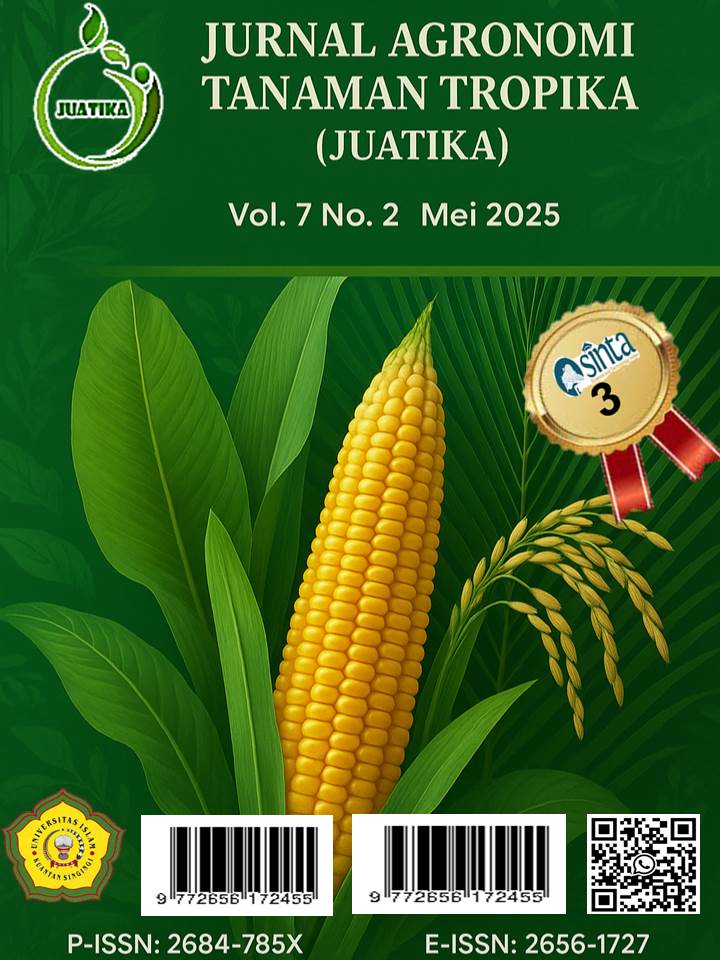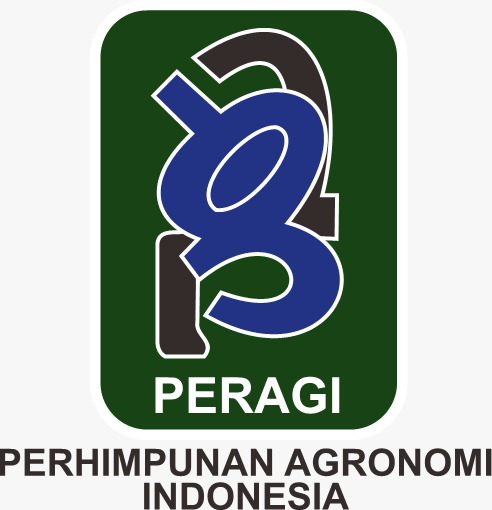The Effect of Kasgot Fertilizer Application on the Chemical Properties of Soil Planted with Cucumbers (Cucumis sativus L.)
Abstract
Sustainable agriculture requires the prudent management of natural resources, including the judicious use of fertilizers and other inputs. One of the primary challenges faced by farmers is the decline in soil fertility resulting from the prolonged use of chemical fertilizers. This study aims to evaluate the effect of Kasgot fertilizer on soil chemical properties, specifically soil pH, organic carbon content, total nitrogen (N), available phosphorus (P), and available potassium (K), in cucumber cultivation. Soil sampling was conducted using a proportional sampling method, where sample points were selected based on soil availability and were representative of the cucumber cultivation area. The results indicated that, based on the analysis of phosphorus (P) and potassium (K) nutrient content, the treatment with 5 grams per planting hole was most effective in increasing phosphorus availability to 0.2907%, classified as high. Meanwhile, the treatments with 10 grams and 20 grams per planting hole were more effective in increasing soil potassium content to 0.0724% and 0.0708%, respectively, both of which were classified as moderate to high.
Downloads
References
Aytenew, M., & Wolancho, G. B. (2020). Effects of organic amendments on soil fertility and environmental quality: A review. Journal of Plant Sciences, 8(5), 112–119.
Baloch, M. S., Zubair, M., & Kakar, K. M. (2020). Influence of soil pH on nutrient availability: A review. [PDF file].
Chen, X., Li, Y., Wang, Z., & Zhang, H. (2022). Co-application of organic amendments and inorganic P increases soil P availability by improving P solubility and microbial biomass. Nature. Retrieved from nature.com / frontiersin.org / mdpi.com
Dinh, T. N., Nguyen, H. V., & Phung, H. N. (2021). Combined application of organic and inorganic fertilizers improves potassium use efficiency and soil fertility in tropical agriculture. Science of the Total Environment, 776, 145939. https://doi.org/10.1016/j.scitotenv.2021.145939
Fauzi, M., Hastiani, L. M., Suhada, A. Q. R., & Hernahadini, N. (2022). The effect of magotsuka kasgot (former maggot) fertilizer on height, number of leaves, leaf surface area, and wet weight of green mustard plants (Brassica rapa var. parachinensia). Journal of Agricultural Science, 20(1), 20–30. http://dx.doi.org/10.32528/agritrop.v20i1.7324
Hasibuan, A. S. Z. (2015). Pemanfaatan bahan organik dalam perbaikan beberapa sifat tanah pasir pantai selatan Kulon Progo. Planta Tropika: Journal of Agro Science, 3(1), 31–40. https://doi.org/10.18196/pt.2015.037.31-40
Kare, B. D. Y., Sukerta, M., Javandira, C., & Ananda, K. D. (2023). Pengaruh pupuk kasgot terhadap pertumbuhan dan hasil tanaman sawi pakcoy (Brassica rapa L.). Agrimeta: Jurnal Pertanian Berbasis Keseimbangan Ekosistem, 13(25), 59–66. https://e-journal.unmas.ac.id/index.php/agrimeta/article/view/6491/4950
Lenaini, I. (2021). Teknik pengambilan sampel purposive dan snowball sampling. HISTORIS: Jurnal Kajian, Penelitian & Pengembangan Pendidikan Sejarah, 6(1), 33–39.
Mading, Y., Mutiara, D., & Novianti, D. (2021). Respons pertumbuhan tanaman mentimun (Cucumis sativus L.) terhadap pemberian kompos fermentasi kotoran sapi. Indobiosains, 3(1), 9. https://doi.org/10.31851/indobiosains.v3i1.4455
Purnomo, R., Santoso, M., & Heddy, S. (2013). The effect of various dosages of organic and inorganic fertilizers on plant growth and yield of cucumber (Cucumis sativus L.). Jurnal Produksi Tanaman, 1(3), 93–100.
Soekamto, M., Soekamto, H., Ohorella, Z., & Kondologit, S. F. (2023). Evaluasi status kesuburan tanah pada lahan budidaya tanaman cabai (Capsicum annuum L.). Agrologia, 12(2), 141–148. http://dx.doi.org/10.30598/ajibt.v12i2
Sulaeman, & Suparto, E. (2005). Analisis kimia tanah, tanaman, air, dan pupuk.
Copyright (c) 2025 Ridho Septyan, Hilwa Walida, Fitra Syawal Harahap, Ika Ayu Putri Septyani

This work is licensed under a Creative Commons Attribution 4.0 International License.
Authors who publish with Jurnal Agronomi Tanaman Tropika (JUATIKA) agree to the following terms:
Authors retain copyright and grant the Jurnal Agronomi Tanaman Tropika (JUATIKA) right of first publication with the work simultaneously licensed under a Creative Commons Attribution License (CC BY 4.0) that allows others to share (copy and redistribute the material in any medium or format) and adapt (remix, transform, and build upon the material for any purpose, even commercially) with an acknowledgment of the work's authorship and initial publication in Jurnal Agronomi Tanaman Tropika (JUATIKA).
Authors are able to enter into separate, additional contractual arrangements for the non-exclusive distribution of the journal's published version of the work (e.g., post it to an institutional repository or publish it in a book), with an acknowledgment of its initial publication in Jurnal Agronomi Tanaman Tropika (JUATIKA). Authors are permitted and encouraged to post their work online (e.g., in institutional repositories or on their website) prior to and during the submission process, as it can lead to productive exchanges, as well as earlier and greater citation of published work.







 More Information
More Information



